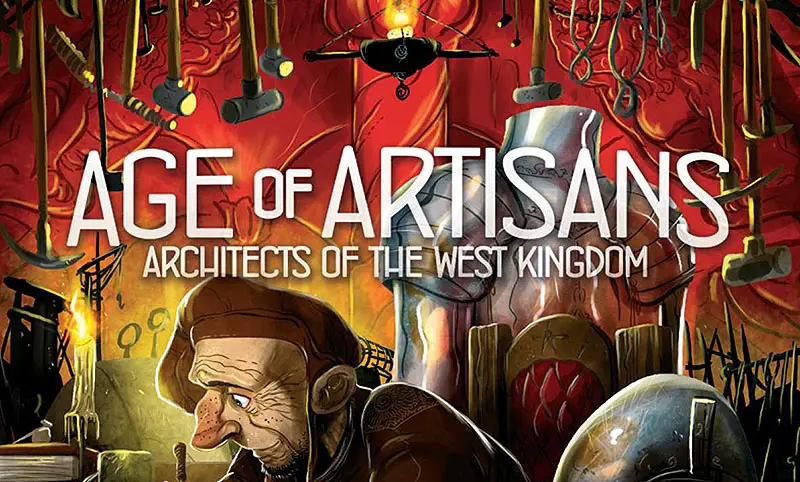
In Architects of the West Kingdom: Age of Artisans, journeymen have returned to the city as master craftsmen, equipped with knowledge of new crafts and tools.
The guildhall has never been so busy! While some apprentices spend time learning new skills, others adorn the city's buildings with everything from golden tapestries, to stained glass windows.
But don't let the shimmer of lights and fancy wares deceive you. For not all that glitters is gold.
Components

- 2 Orange Player Markers
- 20 Orange Workers
- 6 Artisans (In 6 Colors)
- 1 Black Market Overlay Card
- 12 Building Cards
- 24 Craft Cards
- 12 Apprentice Cards
- 1 Guildhall Board
- 6 Player Aids
- 2 Double-sided Player Boards
- 1 Score Pad
- Instructions
Setup
Setup Architects of the West Kingdom as described in the original rulebook, with the following changes:
-
Place the Guildhall Board over the top of the original Guildhall area of the Main Board. Also place the Black Market Overlay Card in the middle space of the Black Market, covering the original iconography.
-
When preparing the Apprentice and Building Card draw piles, shuffle the new expansion cards into their respective piles.
-
Shuffle all Craft Cards and place them in a facedown pile above the Guildhall. From the top of the pile, reveal and place 4 Craft Cards faceup in a row along the top of the Main Board.
-
When choosing player colors, Orange is now also an option. If using the Standard Setup, the Orange player may use either of the new Player Boards. If using the Variable Setup, Side 2 of these Player Boards provide new powers and starting configurations for players to choose from (see page 12.
-
Each player takes 1 Player Aid and 1 Artisan in their chosen color.
-
In reverse turn order, each player hires (at no cost, 1 faceup Apprentice from the Main Board. Once all players have chosen a starting Apprentice, reveal new Apprentice Cards to replace those that were taken.
This Apprentice draft should be done before players draft Building Cards. Be sure to lose or gain Virtue from chosen Apprentices if necessary.
Notes for Games with 6 Players:
As with the 5 player game, the game ends once all spaces in the Guildhall have been filled with Workers.
The base game rules require players to add "2 cards per player, plus 1" to the Reward deck. However, there are not enough Reward Cards in the original game to make this true for 6 players.
In this case, just use all possible cards. If using any additional Reward Cards from future expansions or promos, be sure to refer back to the original setup rules (2 per player, plus 1).
Guildhall Board
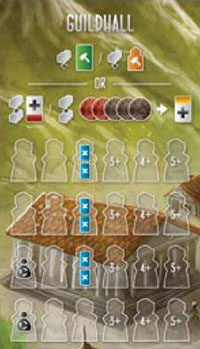
The new Guildhall Board includes 2 new possible actions (crafting Adornments and Tools , and also 3 spaces that now trigger an Apprentice reset.
To craft an Adornment or Tool, players must lay down 1 of their Workers on top of 1 of their previously placed Workers in the Guildhall.
Players cannot place Workers on top of their opponents' Workers. Players can never have more than 2 Workers on a single Guildhall space.

When placing the first Worker over 1 of the Guildhall spaces containing these icons, discard both Apprentices in the left-most column on the Main Board and refill the empty spaces as normal.
This should only happen after the current player has completed their turn in full. Any Silver on discarded Apprentice Cards should be returned to the Supply.
Crafting Adornments

Adornments reward players with immediate benefits and additional Victory Points at the game's end. To craft an Adornment, players should follow these steps:
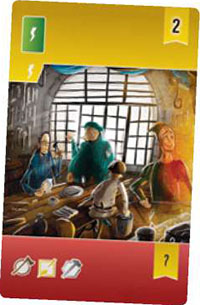
-
Place a Worker from their supply on top of 1 of their previously placed Workers in the Guildhall.
-
Pay 2 Silver to the Tax Stand and 3 Silver to the Supply.
-
Select 1 of the 4 Craft Cards above the Main Board. Note that these are multi-use cards. When crafting an Adornment, players are only concerned with the top section of each card.
-
Tuck the crafted Adornment underneath 1 of their previously constructed Building Cards, so that only the top section of the card can be seen.
Important Rules: Players can only have 1 Adornment attached to each Building. If players do not have an available Building in front of them, they cannot craft an Adornment.
-
Resolve the immediate benefits (or punishments) of the Adornment.
-
Turn over the top Craft Card from the draw pile to replace the card that was taken. If there are no more cards in the draw pile, nothing happens. These cards are intended to be a limited resource.

For example, a player just placed 1 of their Workers on top of 1 of their previously placed Workers in the Guildhall.
They paid the required Silver and decided to craft the Adornment seen here to the right.
They tucked the Adornment behind their Courtyard and gained 3 Clay from the supply, as indicated on the Adornment.
This Adornment will also score them an additional 3 VP at the game's end.
Once attached to a Building, Adornments cannot be moved to a different Building.
Adornment Effects
Most Adornments either reward resources, gain Debts, or affect Virtue. However, there are a few that may require more clarification:
-

Reactivate the immediate reward of the attached Building (attaching this to an end-game scoring Building has no effect).
-

Release all your captured Workers or make 1 Capture.
-

Discard all Apprentices from the Main Board. Reveal 8 new Apprentices, then Hire 1 at no cost.
-

Release all your Workers from Prison.
Crafting Tools

Tools upgrade Apprentices with new abilities and earn additional Victory Points at the game's end. To craft a Tool, players should follow these steps:
-
Either place a Worker from their supply on top of 1 of their previously placed Workers in the Guildhall, or place a Worker at the middle space of the Black Market (this costs 2 Silver and 1 Virtue, rather than committing a Worker to the Guildhall permanently).
-
Select 1 of the 4 Craft Cards above the Main Board. Note that these are multi-use cards. When crafting a Tool, players are only concerned with the bottom section of each card.
-
Tuck the crafted Tool Card underneath 1 of their Apprentices, so that only the bottom section of the card can be seen.
Important Rules: Players can only have 1 Tool attached to each Apprentice. If players do not have an available Apprentice in front of them, they cannot craft a Tool.
-
Turn over the top Craft Card from the draw pile to replace the card that was taken. If there are no more cards in the draw pile, nothing happens. These cards are intended to be a limited resource.
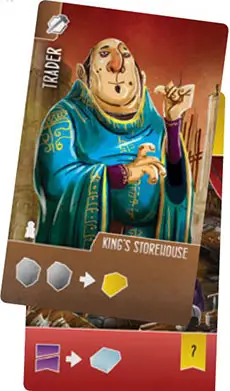
For example, a player just placed 1 of their Workers on top of 1 of their previously placed Workers in the Guildhall.
They crafted the Tool seen here and tucked it behind their Trader Apprentice. From now on, once per turn, when using their Trader, they may also choose to lose 1 Virtue to gain 1 Marble.
As this was their first Tool, this will score them 1 VP at the game's end.
Players are reminded of how Apprentices are scored along the bottom for their new Player Aids.

Tool Effects
Attaching Tools to Apprentices can create a variety of weird and wonderful combinations. For this reason, there are a few important rules to outline:
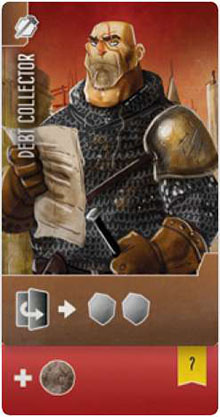
-
Each Tool can only be activated once per player turn or Black Market Reset.
For example, regardless of how many times this Debt Collector is used in a player's turn, it will only ever reward 1 Silver that turn (not 1 per Debt paid).
-
Players must be able to benefit from an Apprentice's ability in order to activate the effect of their Tool.
However, if this would be true, players may decide to resolve a Tool before resolving their Apprentice.
For example, if a player needed 6 Silver to pay off their Debt, but only had 5, they could activate the Tool from their Debt Collector (gaining 1 Silver), as this would allow them to pay off a Debt, therefore activating their Debt Collector's ability.
In other words, Tools can be treated as a reward, or as a discount when applicable.
-
Once attached to an Apprentice, Tools cannot be moved or removed. If however, an Apprentice must be discarded by some effect, any Tool they had may be repurposed to 1 of their other available Apprentices.
In the rare case that this is not possible, they must discard the Tool from the game.
Note that some combinations should be avoided strategically. For example, having a Tool that captures Workers when taking an action would not pair well with the abilities of Squires or Peddlers (it would never activate the Tool, as their abilities activate during a Black Market Reset).
Tool & Apprentice Examples
To offer some more clarity around how some Apprentices and Tools can work together, here are a few examples:
-

This Tool is never activated. Instead, it provides this Abbot with 1 more Skill of each type.
This counts for constructing Buildings and also when scoring Buildings such as the Mason's Hut and Dormitory.
-

This Conspirator allows players to pay 1 less Silver when capturing Workers. The first capture always requires 1 Tax to be paid.
However, they may use the Silver they would gain from the Tool to pay the Tax requirement of the first capture (but only if they were to make a second capture, therefore activating their Conspirator that turn).
-

When placing a Worker at the Town center, the Antagonist always acts as if they have an extra Worker present.
As this is a passive ability, their Tool will activate every time they use the Town center, gaining them 1 Building Card.
-
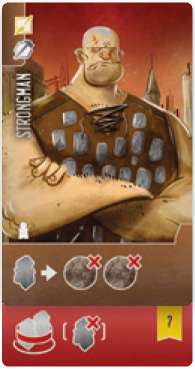
This Strongman allows players to pay 2 less Silver when placing their Artisan.
If they benefited from this Strongman's ability, they may also immediately capture up to 2 Workers of a single color (but not their own Artisan) from the location where they placed their Artisan (captures with this Tool must always be from their placed worker's location).
-

During each Black Market Reset, this Squire will earn 1 Gold if they have no Workers in Prison.
However, if they had only 1 Worker in Prison, this Tool would allow them to free that Prisoner, as it would result in their Squire benefiting from the Tool's ability.
Artisans

Each player now has 1 Artisan. For most intents and purposes, this is like any other Worker.
However, there are some additional rules for this unique Worker:
-
When placing an Artisan, it counts as 2 Workers.
However, it only counts as a single Worker on future turns.
For example, if a player, having no Workers at the Forest, placed their Artisan there, they would gain 2 Wood.
However, on their next turn, if they placed a regular Worker at the Forest, they would still only gain 2 Wood (as their Artisan now only counts as a single Worker, not as 2 when it was placed).
-
When placing an Artisan, it may ignore 1 Virtue loss.
For example, if a player used their Artisan at the Tax Stand, they would only lose 1 Virtue, rather than 2. Likewise, if they used their Artisan to hire an apprentice that would usually result in a Virtue loss, they would ignore it.
Players are reminded of these 2 Artisan abilities on their new Player Aids.
Artisans can be captured, just like any other Worker. They are still worth only 1 Silver when sent to Prison and count as just 1 Worker while in Prison.
As a general rule, any action that can affect a regular Worker, can also affect an Artisan in the same way. Artisans may never be placed into the Guildhall.

= Any Worker (regular Or Artisan)

=Artisan
End of the Game
The game ends in the same way as the original game. Players can use the provided Score Pad to tally up their scores. In addition to the original scoring steps, players also score Victory Points for their Adornments and Tools.

Adornments score Victory Points as indicated in the top right of each card. Players score increasing amounts of Victory Points, with each Tool they acquire.
For example, as seen on the Player Aid here, if a player had 3 Tools, they would score 4 VP, whereas 5 Tools would score a total of 9 VP.
Solo Variant
Setup the Solo Variant for Architects of the West Kingdom as described in the original rulebook, with the additional steps also outlined on page 3 of this rulebook.
Your opponent plays exactly the same way as in the original game, with 1 exception. Any time they place a Worker in the Guildhall, not only do they follow any steps outlined on their Scheme Card, but they also craft 1 Adornment.
Note that they still only place 1 Worker to make this happen. They never stack Workers in the Guildhall.
When crafting Adornments, they are not affected by any of the immediate benefits (or punishments) of the cards. They are only concerned with the printed Victory Points of Adornments. Simply take the card and keep it faceup near your opponent's Board for end-game scoring.
Your opponent will always craft the faceup Adornment with the most Victory Points printed in the top right of the card. If there is more than 1 possible option (equal VPs, shuffle these cards and give 1 to your opponent randomly.
Return the other cards back to the faceup display. After doing so, turn over the top card from the Craft Card Draw Pile to replace the 1 that was taken.
In addition to the original scoring steps, your opponent will also score Victory Points for all their crafted Adornments.
New Apprentices
-

Abbot - Gain 1 Silver when placing a Worker at the King's Storehouse.
-

Antagonist - Treat the Town center as if you have an extra Worker there.
-

Enforcer - Gain the indicated items when sending Workers to Prison.
-

Lookout - Treat the Guardhouse as if you have an extra Worker there.
-

Strongman - Upgrade the abilities of your Artisan. They also have 2 Skills, rather than just 1.
Strongman Abilities

Your Artisan always pays up to 2 less Silver when placed, for a single action that turn.
For example, this might provide a discount on hiring an Apprentice, visiting the Black Market or using a Merchant's ability at the King's Storehouse.

Your Artisan captures all Workers of a single color from the location where it is placed.
You may use this ability to capture your own Workers, but cannot be used to capture your own Artisan.

Your Artisan will be released from Prison during each Black Market Reset.
Variable Player Powers

Walaric
Begins the game with no Workers in Prison, no Silver, 12 Virtue, 1 Tool (chosen from those available after the Building Card draft) and 1 Debt. His Artisan also counts as 3 Workers when being placed.

Gisela
Begins the game with no Workers in Prison, 2 Silver and 13 Virtue. Any time she crafts a Tool, she also gains the immediate benefit printed on the Adornment section of that Craft Card, before attaching it to an Apprentice.
New Buildings
Arc - Gain 2 Debts.
Courtyard - Gain 1 Stone, Wood and Clay.
Gallery - Gain 1 Adornment at no cost.
Garrison - Gain 1 Tool at no cost.
Parish - Gain 1 Building Plan per level you have advanced work on the Cathedral.
Pillar - All players gain 3 Silver.
Academy - Gain 1 VP per Tool.
Arcade - Gain 1 Virtue per Adornment.
Cellar - Gain 1 VP per Adornment.
Dormitory - Gain 2 VP per set of 3 unique Skills.
Meeting Room - Gain 1 Virtue per Tool.
Storehouse - Gain 1 Virtue per set of 3 unique Skills.
Continue Reading


